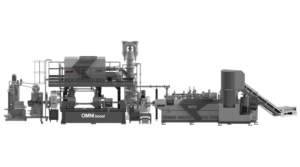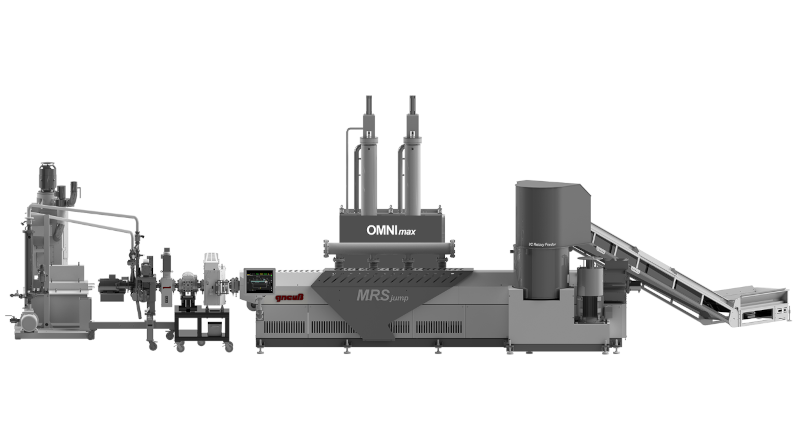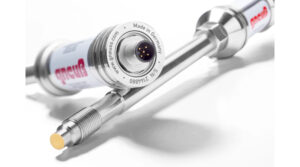Technologies for customisable recycling lines – Gneuss, Hall 10 Booth H31
Gneuss’ MRS extrusion technology has proven itself as an alternative for the reprocessing of contaminated materials like polyester, polystyrene, polypropylene or polyethylenes. In combination with the Gneuss rotary filtration systems and optimised vacuum technology, customisable recycling lines tailor-made for a specific material can be engineered. Several Letters of Non Objection (LNOs) from the FDA, Efsa conformity and local approvals in Latin America confirm the decontamination efficiency of the technology.
Omni recycling system for post-consumer fibre or thermoform reclaim
The Omnimax recycling system processes industrial and post-consumer waste from all kinds of polymers and in all forms and shapes. It includes a 3C rotary feeder, an MRSjump extruder, a fully automatic melt filtration system RSFgenius and an online viscometer VIS.
Gneuss says that the newly developed 3C rotary feeder makes it possible to use low bulk density materials without any external processing steps. A conveyor belt feeds shredded reclaim material into the hopper, where a fast-rotating disc with knives cuts, compacts and pre-conditions the material. The knives add energy into the material and start the heating and degassing process before the material is automatically fed into the MRSjump extruder.
The MRS extruder is based on conventional single screw technology but is equipped with a multiple screw section for devolatilisation. It is claimed to enable efficient and gentle decontamination of PET, whilst achieving the requirements for direct food contact standards. The MRS extruder permits the processing of rPET directly into high quality end products without pre-drying, by using a simple and rugged vacuum system. This is achieved by means of its patented processing section. The multi rotation section is a drum containing multiple satellite single screws, driven by a ring gear and pinion transmission.
The satellite screws rotate in the opposite direction to the main screw. This disproportionately increases the surface exchange of the polymer melt. A large opening for venting, exposing the full length of the satellite screws, is under vacuum. This provides good and unrestricted access to the polymer melt, the surface of which is constantly replaced at a high rate by the action of the satellite screws in the multiple screw section. The surface area – and the surface area exchange rate – available for devolatilisation are far greater than in other extrusion systems, says Gneuss. As the thermal and mechanical stress on the polymer melt is minimised, PET processed on the MRS extruder has good optical and mechanical properties.
The new MRSjump has a longer, modified version of the multi rotation section, which ensures both a longer residence time of the material and more surface area exchange under vacuum. The longer multi rotation section, coupled with a powerful vacuum system operating at 1 mbar, can be used to boost the viscosity of rPET and to hold it at a stable level in spite of variations in the input material. Therefore, there is no need for any liquid phase (LSP) or solid state polymerisation (SSP). With the stabilisation and/or increase of the intrinsic viscosity in the extrusion process, the MRSjump is well suited to recycling e.g. PET film waste or fibre reclaim – applications for which direct recycling with one single extrusion step was previously impossible due to low intrinsic viscosity or variable input viscosities.

Omniboost recycling system including polyreactor Jump
The Omniboost recycling system with a polyreactor Jump is designed to process PET waste into high-quality products. The integrated Jump can lift the IV value of a PET melt up to 0.95 dl/g. In the Jump the polymer passes over several slow turning elements which create a polymer film, the surface of which is constantly renewed. The reactor vessel is kept under vacuum, through which volatile substances are reliably removed. By regulating the residence time in the reactor, the vacuum, the fill level and the speed of rotation of the agitating devices, the polycondensation reaction can be altered to achieve the required product properties.
Filtration technology
The continuous rotary filtration systems are characterised by a filter disk on which the screen cavities are located in a ring pattern. Screens can be changed on the part of the filter disk that is not active in the melt channel, while the production process continues to run without any interruptions or disturbances.
Gneuss’ top model, the RSFgenius, operates with an integrated back-flushing system offering self-cleaning for demanding applications and high quality requirements. Screens can be automatically re-used up to 400 times and filtration finenesses below 10 microns/1,200 mesh are available.
Measuring technology
Gneuss provides flexible sensor solutions for pressure and temperature measurements, individually tailored to specific applications. The latest generation of Gneuss sensors and pressure monitors communicates completely digitally. Integrated RFID chips for digital gauge monitoring are available for all sensor models.
Photo top: Gneuss Omnimax recycling system with MRSjump extrusion system, rotary filtration system and 3C rotary feeder



